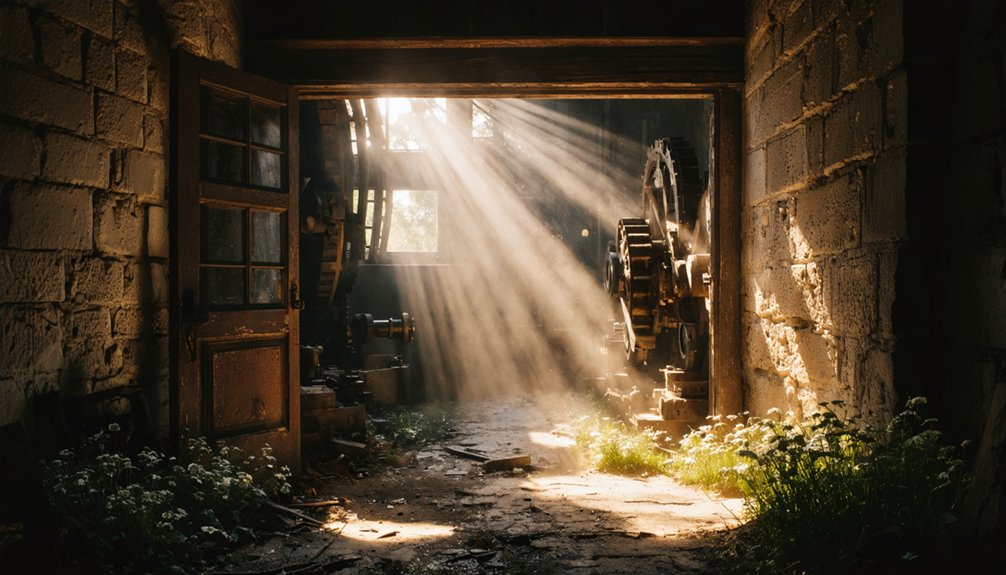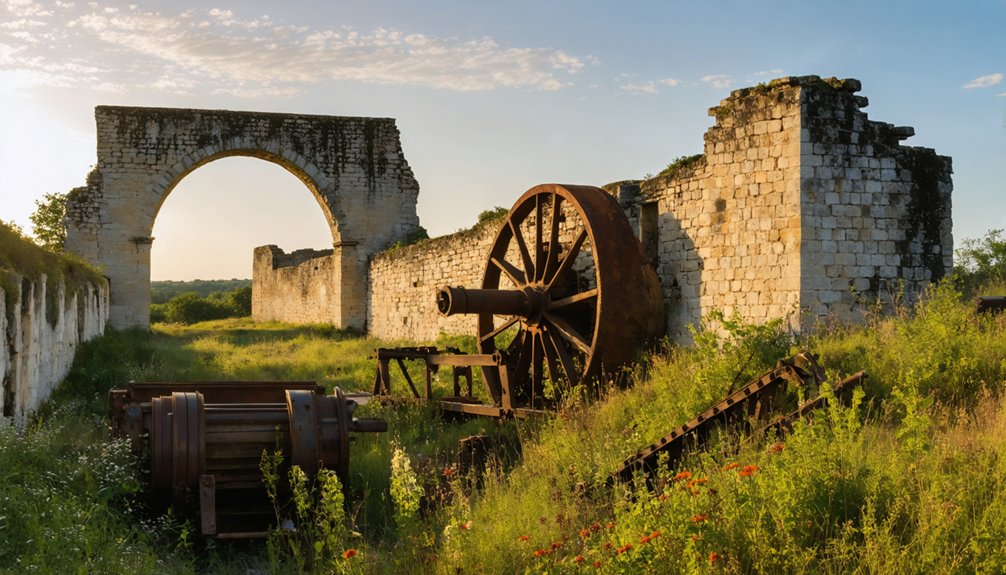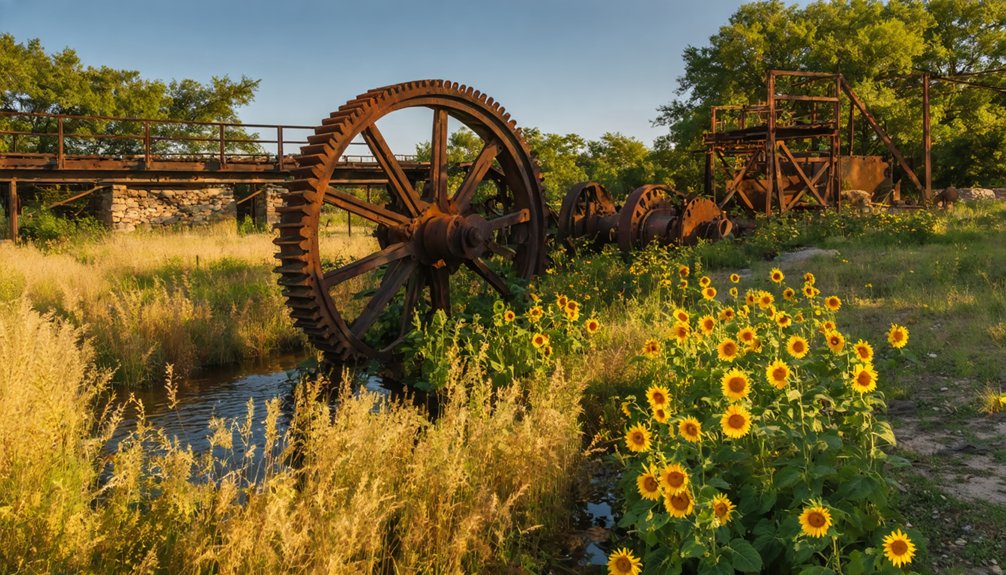You’ll find Mormon Mill’s remains along Hamilton Creek in Burnet County, where religious leader Lyman Wight established a pioneering settlement in 1851. The colony’s mighty three-story mill, powered by a 26-foot waterwheel, served frontier families from Burnet to Austin. While nature’s reclaimed most traces, you can still spot scattered foundations and a historic cemetery marked by weathered gravestones. The settlement’s remarkable story of faith, industry, and survival runs as deep as Hamilton Creek itself.
Key Takeaways
- Mormon Mill was established in 1851 by Lyman Wight and 20 families along Hamilton Creek in Texas as a self-sustaining religious colony.
- The settlement’s centerpiece was a three-story mill with a 26-foot waterwheel that processed flour and lumber for surrounding communities.
- The colony supported approximately 250 settlers who shared labor and resources, operating various crafts and agricultural activities.
- Environmental challenges, debt, religious persecution, and Indian raids led to the community’s eventual abandonment.
- Today, only scattered foundations, a historic cemetery, and a Texas Historical Landmark marker (#9733) remain at the ghost town site.
The Vision of Lyman Wight
While most Mormon followers headed west with Brigham Young after Joseph Smith’s death in 1844, Lyman Wight chose a different path.
You’ll find his story starts in Wisconsin, where he gathered 20 devoted families and headed south down the Missouri River to Texas. Wight wasn’t following someone else’s orders – he’d received prophetic guidance through a vision that would lead his people to a new Zion.
Led by divine revelation, Lyman Wight gathered faithful families from Wisconsin and journeyed south to establish a new Mormon sanctuary in Texas.
As an apostle ordained by Joseph Smith himself, Wight wielded considerable spiritual authority among his followers. In 1851, he led his group to establish Mormon Mill Colony along Hamilton Creek.
He saw Texas as the perfect frontier to build self-sustaining communities free from persecution. His divine vision even led him to specific sites, including the location of millstones they’d use in their settlements.
Unlike Young’s rigid structure, Wight’s leadership offered his followers a chance at true independence. He focused his colony on raising cattle and sheep to establish a sustainable livelihood.
Life in a Self-Sustaining Colony
Following Wight’s prophetic guidance, the Mormon colonists built a remarkable self-sustaining community along Hamilton Creek. Their community dynamics centered on resource sharing, with every member contributing specialized skills to keep the colony thriving.
You’d have found a bustling settlement of about 250 folks, where craftsmen worked alongside farmers to create everything needed for daily life.
Here’s what made the colony tick:
- A mighty three-story mill with a 26-foot waterwheel, powered by Hamilton Creek, produced flour and lumber for the region.
- Local artisans crafted furniture, tools, and textiles, while farmers raised crops and tended livestock.
- A school and cemetery showed their commitment to both education and preserving their heritage.
The successful mill ran continuously for six weeks at its peak productivity. The colony’s independence shone through their mastery of local resources and their ability to trade with neighboring settlements.
The Mighty Mill on Hamilton Creek
When you’d stand at Mormon Mill in 1851, you’d witness a massive 26-foot wooden overshot waterwheel powering both grinding stones and lumber saws in a three-story marvel of frontier engineering.
This dual-purpose powerhouse on Hamilton Creek could run six weeks straight, churning out freshly ground corn and wheat while processing cedar timbers for the entire region.
The mill’s influence stretched from Burnet to Austin, serving as an essential economic hub where locals brought their grain and lumber needs to the industrious Mormon colony. The historic millstones from Mormon Mill are now preserved and displayed at Fort Croghan in Burnet, Texas. The community grew to a bustling population of two hundred fifty settlers at its height.
Water-Powered Engineering Marvel
Standing as one of central Texas’s earliest industrial marvels, the Mormon Mill harnessed Hamilton Creek’s continuous flow through an impressive 26-foot diameter waterwheel integrated into a three-story mill building.
The ingenious waterwheel design and hydraulic efficiency showcased remarkable engineering by Mormon settlers who’d adapted to frontier conditions using local materials. Similar to the run-of-river design seen in modern hydroelectric facilities, the mill maintained a steady flow while minimizing environmental impact. Much like the water-powered mill in Volente that served local farmers, this site became a hub for community gatherings and commerce.
- You’d find clever water management through wooden dam structures that maintained steady power despite seasonal changes.
- The mill’s power system drove both grain grinding and lumber processing operations, supporting your basic homesteading needs.
- Local craftsmen could process raw materials on-site, making the region more self-sufficient and less dependent on distant mills.
This engineering feat wasn’t just about power generation – it represented Texas frontier independence and resourcefulness at its finest.
Lumber and Grain Production
The mighty mill on Hamilton Creek hummed with dual-purpose production, churning out both lumber and grain for central Texas settlers.
You’d find a bustling operation where the 26-foot waterwheel powered everything from lumber harvesting to grain processing, keeping the three-story structure alive with activity.
If you’d brought your wheat or corn, you might’ve waited your turn during peak seasons, but the mill’s continuous operation – sometimes running six weeks straight – served folks from Burnet to Austin.
The circle saw cut through native cedar for lumber and shingles, while skilled Mormon craftsmen turned raw materials into fine furniture.
Though not as large as later industrial operations, you could count on the mill’s output to meet your building needs and keep your family fed, proving essential to frontier life in 1850s Texas.
Like many early sawmills in Texas, the daily production capacity reached approximately 500 to 1,200 board feet.
Following the example of Peter Ellis Bean, early Texas sawmills were vital in addressing the region’s chronic lumber shortage.
Regional Economic Impact
Despite its relatively short lifespan, Mormon Mill became a powerhouse of economic activity that rippled through central Texas in the 1850s.
The area’s early economy focused on stock raising and farming, making the mill’s services essential for processing agricultural products. You’ll find that the mill’s economic resilience shaped early Burnet County’s development, with its 26-foot water wheel powering various operations that served local needs. Through community collaboration, Mormon settlers and their neighbors built a robust local economy.
- Their skilled craftspeople produced essential goods – from furniture to tools – that you couldn’t easily get elsewhere in central Texas.
- The mill’s day-and-night operation provided steady employment for both Mormon residents and local farmers.
- You can trace the region’s early infrastructure development to the forty-five Mormon colonists who helped establish Burnet County in 1851.
Daily Work and Community Spirit

You’d find the Mormon settlers sharing everything from hammers to harvest duties, working shoulder-to-shoulder from sunup to sundown at their impressive three-story mill on Hamilton Creek.
The tight-knit group of around 250 folks pitched in together whether grinding flour, sawing timber, or tending to the 26-foot water wheel that kept their operation humming.
Their shared faith and determination helped them weather the tough Texas frontier life, even as they faced persecution and eventual economic hardship that would scatter their community.
Within Mormon Mill’s bustling settlement, shared labor and tools formed the backbone of daily life, where roughly 250 settlers across 20 families pitched in to keep their three-story mill running day and night.
You’d find folks working in shifts, operating the massive overshot water wheel that powered both grinding and sawing operations. The spirit of communal labor meant everyone had a role to play.
- Men rotated through milling, lumber processing, and blacksmithing duties
- Women crafted willow baskets and clothing to support the community
- Farmers worked collectively to grow food and maintain infrastructure
With shared tools enabling continuous operation for up to six weeks straight, you’d see the mill humming with activity as settlers produced everything from flour to furniture, proving that working together meant thriving together in this Texas frontier community.
Faith Through Hard Work
Faith and determination drove every aspect of life at Mormon Mill, where religious conviction shaped the daily rhythm of work from sunup to sundown.
You’d find settlers putting their faith-based motivation into action through the sweat of collective labor – whether at the three-story mill complex, in the fertile fields, or crafting furniture and cotton goods.
Under Lyman Wight’s leadership, these folks weren’t just working to survive; they were fulfilling what they saw as divine duties.
Their labor ethics ran deep, believing that building a self-reliant community was part of their spiritual calling.
Despite facing debts and threats from hostile neighbors, they’d gather regularly for worship, which reinforced their shared commitment to hard work.
Through every challenge, their religious faith kept them pushing forward, transforming raw wilderness into a thriving settlement.
Challenges That Led to Exodus
The Mormon Mill settlement faced a perfect storm of challenges that ultimately drove its residents to abandon the site.
You’ll find it wasn’t just one issue that broke this hardy community, but rather a combination of crushing setbacks that made staying impossible.
- A massive debt burden from building their three-story mill, combined with economic isolation, strangled their financial hopes.
- Leadership conflicts between Lyman Wight and Brigham Young’s followers split the community, while religious persecution from neighbors made daily life difficult.
- Security concerns from Indian raids kept everyone on edge, and environmental challenges like flooding forced multiple relocations.
These mounting pressures eventually proved too much for even the most determined settlers.
What Remains Today

Although Mormon Mill once bustled with frontier industry, today you’ll find little more than scattered foundations and a historic cemetery marking this ghostly settlement near Marble Falls.
Time and nature have reclaimed most traces of this pioneering community, with Hamilton Creek’s waters still flowing past where the mill once stood.
If you’re exploring the archaeological features, you’ll spot weathered gravestones and building foundations peeking through the overgrowth.
A Texas Historical Landmark marker (#9733) helps guide your visit, though don’t expect developed facilities.
Your visitor experience will be rustic – you’ll need a vehicle that can handle rural roads, and you’ll want to rely on your imagination to picture the once-thriving settlement.
While most physical structures have vanished, the quiet countryside still whispers stories of Mormon Mill’s frontier past.
Historical Impact on Burnet County
Mormon Mill’s influence on Burnet County runs deeper than its scattered remains suggest. You’ll find the settlement’s economic and cultural footprints woven into the region’s early development, particularly through their innovative mill operations and distinctive Mormon culture.
While they kept to themselves politically, these industrious settlers brought valuable skills and commerce to the area.
- The settlement’s three-story mill, powered by Hamilton Creek, became a crucial hub for grain processing and lumber production, serving communities from Burnet to Austin.
- Local farmers benefited from their skilled artisan crafts, including willow basketry, furniture-making, and blacksmithing.
- Though religious tensions existed, the colony’s self-governance and unique customs added diversity to Burnet County’s frontier society, leaving lasting marks through sites like the Mormon cemetery.
Frequently Asked Questions
What Happened to the Mormon Families Who Stayed After Wight Left?
You’ll find those Mormon families kept working at Smithwick’s mill, faced settlement challenges like debt and persecution, but adapted by diversifying into farming and trades while maintaining their community dynamics under local ownership.
Were There Any Conflicts Between Mormon Mill Settlers and Native Tribes?
You bet there were conflicts – just as Native raids intensified across Texas, Mormon Mill settlers faced frequent attacks from Comanche and Kiowa tribes, ultimately contributing to their decision to abandon the settlement.
How Did Local Non-Mormon Residents View the Colony?
You’ll find local perceptions were mixed – while folks appreciated the Mormon Mill’s economic benefits, there were cultural tensions due to religious differences, leading to persecution and an uneasy coexistence.
What Crops and Livestock Were Primarily Raised at Mormon Mill?
Like pioneers seeking freedom, you’d grow corn and wheat as your main crops, grinding them at the mill. Though livestock records are sparse, you’d likely raise chickens and pigs for sustenance.
Did Any Original Mormon Mill Structures Survive Into the 20TH Century?
You won’t find any surviving structures from the original Mormon Mill – they were burned down in 1902 and torn away. Only the historical significance lives on through markers and museum artifacts.
References
- https://www.deseret.com/2016/11/2/20599564/picturing-history-mormon-mill-cemetery-burnet-county-texas/
- https://101highlandlakes.com/mormon-mill-road-in-marble-falls/
- https://www.ghosttowns.com/states/tx/mormonmill.html
- https://en.wikipedia.org/wiki/Mormon_Mill
- https://www.thespectrum.com/story/life/2015/11/21/babylon-ghost-town-like-sunset/76071198/
- https://texashistory.unt.edu/ark:/67531/metapth61101/m1/133/
- https://www.youtube.com/watch?v=62bXwytN_XY&vl=ar
- https://www.fallsmuseum.org/timeline-marble-falls-history.html
- https://www.tshaonline.org/handbook/entries/mormon-mill-colony
- https://historicalgeneralconferences.weebly.com/lyman-wight.html



